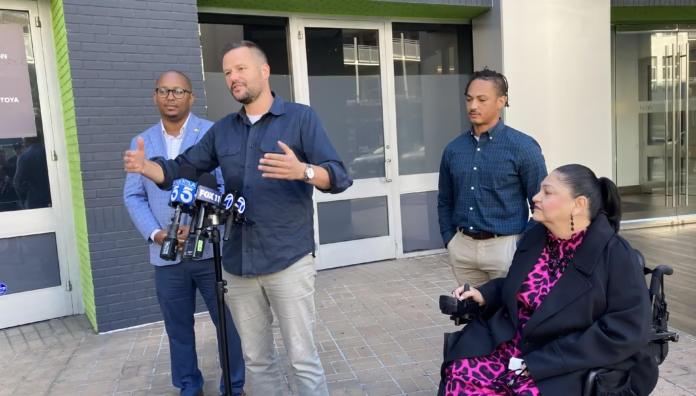“Downtowns are struggling right now,” said State Assemblymember Matt Haney (San Francisco) while visiting Long Beach last month on the fourth of his Select Committee on Downtown Recovery’s eight-stop statewide tour. “A lot of people won’t come downtown. […] They don’t think it’s safe. They don’t think we’re dealing with homelessness. They’re worried about the vacancy rates. [… But] even though our downtowns have struggled during the pandemic, they’re coming back in many cases — like in Long Beach — even stronger, and they’re being reimagined in new and exciting ways.”
But the numbers show Long Beach has not come back stronger. Despite a decade-plus push to increase population density by building 5,000 new units — a goal which the city has overshot by 1,500 — according to the Downtown Long Beach Alliance’s (DLBA) two most recent annual reports, downtown’s stabilized occupancy dropped from 77% in 2022 to 66% in 2023, with average neighborhood retail occupancy plummeting from 92% to 77% — this despite the city’s being home to some of the cheapest retail and office space in Los Angeles County.
What is Long Beach doing wrong? Haney did not respond to questions for this article.
What Haney did say on his “walking tour” of downtown — which in total constituted two staged stops on the Promenade to hear from one business owner, one real-estate broker, and one landlord before terminating at the Long Beach Convention Center — is that the way forward largely hinges on “a statewide recovery plan, with real investments and real leadership from the state,” with his Select Committee’s findings leading to “the introduction of a set of legislation and investments to support our downtowns.”
Mayor Rex Richardson — who gave remarks and fielded questions before the tour began but did not come along — spoke of needing “a more inclusive [and] diverse economy in our downtown, [which is] what you’re seeing happening in our investments into entertainment, the 24/7 economy, housing — all of those things”; and that the best way to address “challenges” such as increased crime is to have “an activated corridor, an activated downtown. The more we activate it, the safer the community.”
Specifics, though, were not on the agenda. The closest anyone came was when Richardson and Haney spoke of the need to cut through state government red tape to make it easier to convert “empty buildings” that pre-pandemic were used to be office space into alternate/mixed uses.
“[T]here are some things in our state where we are getting in the way of solutions that our local leaders want to see,” said Haney. “[… I]n many cases there’s red tape in bureaucracy that the state is putting away that we need to get out of the way so that local leaders can get this done. […] We have to get people back into some of these empty buildings, particularly the ones that we have some control over, like the state buildings. […] If the state is not going to bring back the workers because they’ve now moved to remote work, then we should turn the buildings back over to somebody who’ll use it — like, use it or lose it. […] It’s been a couple of years now, and there is no plan to bring back those workers.”
But it does not appear this has anything to do with Long Beach.
DLBA president/CEO Austin Metoyer declined to comment on whether even a single such “empty building” exists downtown, but he more or less admitted that what Haney has in mind isn’t really applicable to Long Beach.
“Downtown Long Beach does not have many state-owned or occupied properties, but features a mix of ownership types, including state, federal and city government properties, with the majority owned by private organizations and individuals. The tour highlighted Sacramento as a comparison, but their downtown is very different. State-owned or occupied buildings in Downtown Long Beach include the George Deukmejian Courthouse […] as well as the CSU Chancellor’s Office, operated by the California State University system. I cannot comment on their utilization by state employees; however, both buildings are currently occupied, with the Courthouse notably resuming in-person cases.”
With regards to safety, Haney stated the obvious: “If people don’t feel safe, we’re not going to be successful anywhere — especially in our downtowns.” But speakers featured during the staged stops were not encouraged by where Long Beach is at. “Families aren’t coming downtown because they don’t feel safe,” said Clare Le Bras, general manager of the Ordinarie, a tavern on the Promenade. Sheva Hosseinzadeh, a principal broker with Coldwell Banker Commercial BLAIR, concurred: “I think [crime is] the one thing that’s deterring our businesses downtown right now. They just want better safety measures, and, you know, want the city to have some sort of initiative for the unhoused.”
Bob Ruth, founding partner of a commercial real estate and investment firm whose holdings include 211 E. Ocean Blvd., spoke of a long-term challenge to bringing new commercial tenants into Long Beach: area access.
“There are a lot of trucks on [the 710] freeway, there’s a lot of chaos […] And when we talk about trying to create large events in downtown Long Beach, we’ve got to find ways to make it easier to get in and out,” said Ruth. “[…] If we could get some assistance [from state government] on getting in and out, I think that would be very, very helpful.”
In response, Haney noted that in coming years state government will be making some transit decisions in light of the Olympics that could have long-term positive effects — but that there’s no time to waste.
“I hope this will be a moment, but the clock is ticking,” he said. “[…] I think the state has an even greater and more important role to play now that there’s some uncertainty around support from the federal government.”



